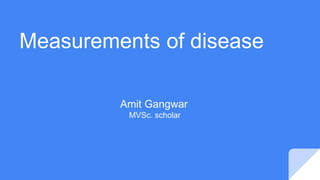
Measurements of disease.pptx by Dr. Amit gangwar
- 1. Measurements of disease Amit Gangwar MVSc. scholar
- 2. Tool of measurements ● RATIO ● RATE ● PROPORTION
- 3. RATIO ● The value obtained by dividing one quantity by other - X/Y. ● relations between two quantities. ● Numerator is not a part of denominator. Ex. - Male : Female ratio WBC : RBC ratio
- 4. RATE ● expresses a change in one quantity (the numerator) with respect to another quantity (the denominator). ● ‘Time’ is included in the denominator. ● Ex. - Velocity (e.g., 10 m per second) is a rate.
- 5. Proportion ● Relation between two quantities. ● Numerator always parts of denominator. Ex. - prevalence, case fatality are proportions.
- 6. Measurements of morbidity Incidence ● Occurrence of new cases Prevalence ● Existence of all new & old cases.
- 8. Prevalence number of individuals having a disease at a particular point in time P = —————————————————————————————— number of individuals in the population at risk at that point in time
- 9. Prevalence Point prevalence ● the amount of disease in a population at a particular point in time. Period prevalence ● number of cases that are known to have occurred during a specified period of time. ● Ex. - a year (annual prevalence).
- 10. INCIDENCE Two components: 1 - the number of new cases; 2 - the period of time over which the new cases occur.
- 11. Cumulative incidence Incidence Rate ● Proportion number of individuals that become diseased during a particular period ——————————————————————————————— number of healthy individuals in population at beginning of that period ● Rate number of new cases of disease that occur in a population during a particular period of time ————————————————————————————————— the sum, over all individuals, of the length of time at risk of developing disease
- 12. The relationship between prevalence and incidence rate ● P = I x D ● This means that a change in prevalence can be due to: 1 - a change in incidence rate. 2 - a change in the average duration of the disease. 3 - a change in both incidence rate and duration.
- 13. Attack rate Secondary attack rate ● describe the proportion of animals that develop the disease, when period of risk is brief. ● Rate at which disease is spreading. ● Expressed in %. ● proportion of cases of a transmissible disease that develop when contact with the primary case.
- 14. Mortality ● When the relevant outcome is death. ● Rather than new case of a specific disease.
- 15. Cumulative mortality ● estimated same as cumulative incidence. ● number of individuals that die during a particular period number of individuals in the population at the beginning of the period
- 16. Mortality rate ● Calculated same as incidence rate. number of deaths due to a disease that occur in a population particular period of time M= the sum over all individuals, of the length of time at risk of dying
- 17. Death rate ● The death rate is the total mortality rate for all diseases ● rather than one specific disease, in a population.
- 18. Case fatality rate ● The tendency for a condition to cause the death of affected animals in a specified time is the case fatality. ● proportion of diseased animals that die. number of deaths number of diseased animals
- 19. Measures CRUDE ● Crude prevalence, incidence and mortality values are an expression of the amount of disease and deaths in a population as a whole. ● no account of the structure of the population affected. SPECIFIC ● describe disease occurrence in specific categories of the population. ● related to host such as age, sex, breed and method of husbandry, and, in man, occupation and socio-economic group. ● convey more information than crude measures on the pattern of disease. ● can indicate categories of animal that are particularly at risk of disease, and can provide evidence on its cause.
- 20. Measures Adjusted (standardised) ● Remove confounding of different age structures. ● Adjusting the crude values. ● reflect the values that would be expected if the potentially confounding characteristics were similarly distributed in the two study populations.
- 21. Mapping ● displaying the geographical (spatial) distribution of disease by drawing maps (cartography). ● recording of areas where diseases exist but also in investigating the mode and direction of transmission of infectious diseases.
- 22. POINT/DOT MAP ● illustrate outbreaks of disease in discrete locations, by circles, squares, dots or other symbols. ● Qualitative. ● Direction of spread of disease.
- 23. DISTRIBUTION MAP ● show the area over which disease occurs.
- 24. PROPORTIONAL CIRCLE MAP ● Morbidity and mortality can be depicted using circles whose area is proportional to the amount of disease or deaths. ● Shading is used to give the impression of spheres on a two- dimensional map.
- 25. CHOROPLETHIC MAP ● Greek: choros = ‘an area’, ‘a region’; plethos = ‘a throng’, ‘a crowd’, ‘the population. ● display quantitative information as discrete shaded units of areas. ● graded in intensity to represent the variability of the mapped data.
- 26. ISO PLETHIC MAP ● True boundaries between different values is depicted by joining all points of equal value by a line.
- 27. Why should we measure it? ● Describe the extent and nature of disease n community - assist in establishing priorities. ● Provide essential data for research. ● Starting point for etiological disease, help in PREVENTION. ● Monitoring and evaluation of disease control activities.
- 28. Thanks! Reference: Veterinary epidemiology, 3rd edition (Michael thrusfield)